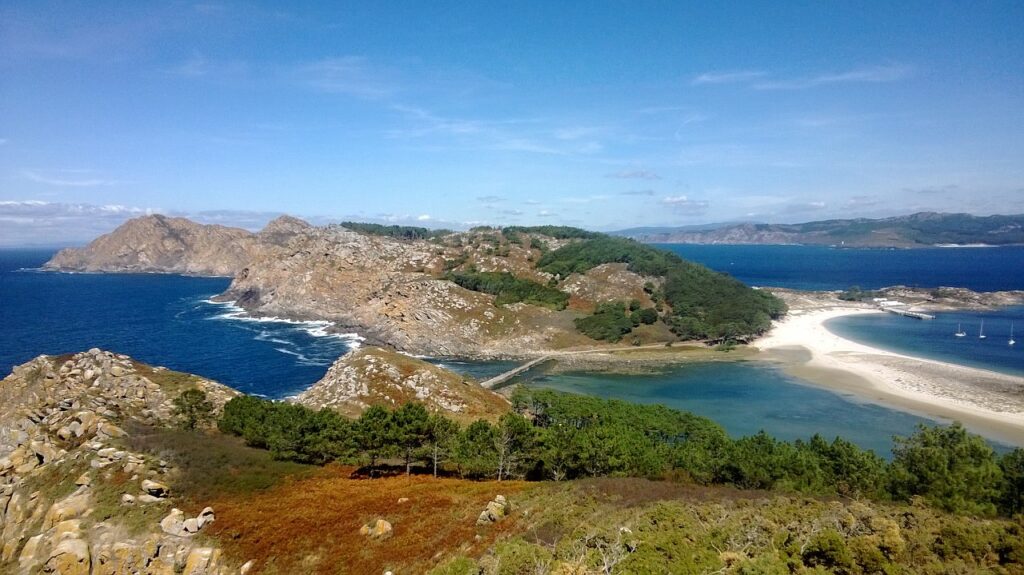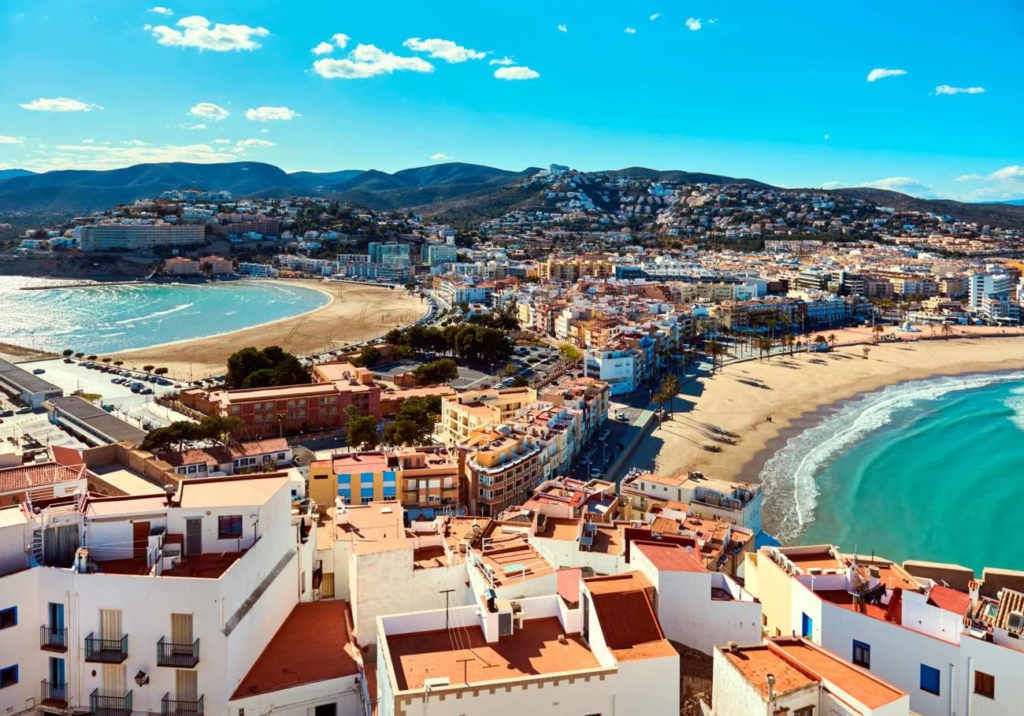The Cies Islands are a hidden gem off the coast of Galicia, in northwest Spain. This small archipelago offers pristine beaches, crystal-clear waters, and stunning hiking trails. Visitors often call it an unspoiled paradise, ideal for those who love nature and tranquility. The islands form part of the Atlantic Islands of Galicia National Park. They are carefully protected to preserve their unique flora and fauna. If you long for peace, impressive coastal landscapes, and a glimpse into Spain’s natural wonders, the Cies Islands are the perfect destination.
In this travel guide, we’ll explore everything you need to know before visiting. We’ll cover how to get there, the best time to go, and what to see and do. We’ll also provide tips on lodging, dining, and environmental guidelines. By the end of this article, you’ll be ready to plan your trip to one of Europe’s best-kept secrets.

Why the Cies Islands Are a Must-See Destination
The Cies Islands consist of three main islands: Monteagudo (North Island), do Faro (Lighthouse Island), and San Martiño (South Island). Two of these islands are connected by the famous Rodas Beach. This beach was once labeled the “best beach in the world” by a British newspaper. Powdery white sand meets turquoise water, creating a postcard-perfect setting.
Bird enthusiasts flock here for the large colonies of seabirds. Gulls, cormorants, and other species nest in the cliffs and coastal areas. This abundance of birdlife, combined with the islands’ isolation, gives travelers a sense of escape from the modern world. The archipelago is also home to unique plant species. Many of these plants thrive in the islands’ mild and humid climate.
Underwater, you’ll find a diverse marine ecosystem. Snorkeling reveals colorful fish, starfish, and other marine creatures. Low-impact tourism and protected status help maintain this natural balance. For travelers wanting to explore a lesser-known part of Spain, the Cies Islands provide an experience that is both serene and adventurous.
When to Visit the Cies Islands
Most people visit from late spring to early autumn. Summers are warm, with average daytime highs around 24°C (75°F). In July and August, the weather is ideal for sunbathing on the beaches and swimming in the ocean. However, this is also the peak season. Ferry tickets and campsite spots can sell out quickly, so advance booking is essential.
Spring and early autumn offer milder weather. Fewer crowds mean more peace when wandering the trails and enjoying the scenery. Even in these shoulder seasons, sunny days can be perfect for outdoor activities. Yet, weather can change quickly on the Galician coast, and rainfall is common. Always pack a light jacket or raincoat. That way, you can handle the occasional storm or cool evening breeze.
How to Get to the Cies Islands
Access to the Cies Islands is possible only by boat, typically departing from the coastal city of Vigo. Ferries also run from nearby towns such as Cangas and Baiona during peak season. The journey takes about 45 minutes from Vigo, passing through the scenic Ría de Vigo estuary. You’ll get panoramic views of the Atlantic and the Galician coastline.
Booking Ferry Tickets in Advance
A daily limit on visitors exists to protect the islands’ fragile ecosystem. You must reserve your ferry tickets in advance, especially if you travel in high season. Many companies offer round-trip tickets. Check departure times carefully, as ferries usually run less frequently in spring and autumn. Outside peak months, schedules can be limited or canceled if the weather is bad.
Private Boat or Yacht
Some visitors arrive by private yacht or sailboat. If you plan to do so, you still need a special permit from the park authorities. Mooring is only allowed in designated areas. Strict regulations are in place to prevent environmental harm to the seafloor and protect marine life.
Top Attractions and Things to Do on the Cies Islands
Whether you want to relax on a pristine beach or tackle rugged hiking routes, the Cies Islands have plenty to offer. Below are some of the best attractions and activities you’ll find.
Relax on Rodas Beach
Rodas Beach connects Monteagudo and do Faro, forming a natural lagoon. Its fine white sand and transparent waters are ideal for sunbathing and swimming. Many visitors spend the entire day here, as the scenery is unforgettable. Arriving early helps secure a comfortable spot on busy summer days.
Hike Scenic Trails
The Cies Islands boast several hiking routes of varying difficulty. One popular path is the Ruta do Faro, leading you to a historic lighthouse with panoramic views. Another is the Ruta do Alto do Príncipe, a shorter trail that reaches a viewpoint overlooking the Atlantic. Remember to wear sturdy shoes, carry water, and respect any trail closures meant to protect wildlife habitats.
Explore Marine Life
Snorkeling and kayaking are popular water activities around these islands. The Atlantic waters remain cooler than the Mediterranean, so a wetsuit may be useful. Local operators can provide guided tours, especially in summer. You’ll see colorful fish, octopuses, and occasionally playful dolphins near the ferry routes.
Observe Bird Colonies
One of the most distinctive features of the Cies Islands is their bird population. The islands are a haven for breeding gulls and cormorants. Seabirds nest in cliffside areas, so tread carefully if you venture near nesting sites. Bird-watching tours are available. These tours typically include experts who explain local species, migratory patterns, and conservation efforts.
Where to Eat and Drink
Dining options on the Cies Islands are limited, reflecting the focus on conserving their natural state. A handful of restaurants and snack bars operate near the main pier area on do Faro Island. They serve fresh seafood, sandwiches, and cold drinks. However, prices can be higher than on the mainland. Bringing your own picnic is a great alternative, but remember to manage your waste responsibly.
For a more diverse dining experience, stay in the city of Vigo or in Cangas. There, you’ll find top-quality Galician cuisine, often featuring fresh fish, shellfish, and the region’s famous empanadas. Don’t miss out on trying local specialties such as pulpo a la gallega (Galician-style octopus) and Albariño wine from nearby vineyards.
Accommodation Options on the Cies Islands
Overnight stays on the Cies Islands are limited to camping. The sole campsite is located behind Rodas Beach on do Faro Island. Booking well in advance is crucial, especially in peak season. The campsite offers basic facilities like showers, toilets, and a small shop for essentials. You can either rent a tent on-site or bring your own equipment.
If camping isn’t your style, you’ll find a range of accommodations on the mainland, particularly in Vigo. There, you can choose from budget hostels, apartments, or upscale hotels. This option allows you to enjoy a day trip to the islands. You’ll return to the comforts of a city after a day of hiking or beach fun. Always check ferry schedules, especially if you plan a same-day return.
Environmental Preservation and Visitor Guidelines
The Cies Islands are part of a protected national park. Their fragile ecosystem faces constant pressure from tourism. Authorities have established rules to ensure visitors treat the environment with respect:
Daily Visitor Limit
Only a limited number of visitors can arrive each day. Book ahead to secure a place on the ferry.Leave No Trace
Littering is strictly forbidden. Carry all rubbish back with you or use designated bins.Restricted Camping
Camping is allowed only at the official campsite. Wild camping is illegal.Flora and Fauna Protection
Collecting shells, rocks, or plants is prohibited. Birds and other wildlife should never be disturbed.
By following these guidelines, you help conserve the pristine condition of this natural treasure. The park authority works tirelessly to maintain this environment, ensuring future generations can enjoy it.
FAQs About the Cies Islands
Is a permit required to visit the Cies Islands?
Yes. The daily visitor number is limited, so you must reserve a spot on a ferry or obtain a permit if arriving by private boat. This system helps protect the islands’ natural beauty.
Can I visit the Cies Islands during the winter months?
Ferries typically operate from spring to early autumn. In winter, they run only on specific dates or do not run at all. Always check with ferry operators for updated schedules.
Are there any restaurants or shops on the islands?
You’ll find a few cafés, bars, and a mini-market near the main pier and campsite area. They offer basic snacks, meals, and drinks. However, options can be limited and more expensive than on the mainland.
Is Rodas Beach suitable for children?
Yes. Rodas Beach has a gentle slope and calm waters on good weather days. Families do need to keep an eye on younger children, as there are no lifeguards on duty. Always supervise kids at the water’s edge.
How can I get around the islands?
Most of the Cies Islands are explored on foot. Marked trails connect the main points of interest. You can’t bring cars or bikes. The islands are small, so walking is an enjoyable way to see everything.
What should I pack for a day trip to the Cies Islands?
Bring comfortable walking shoes, a swimsuit, a light jacket or raincoat, sunscreen, and drinking water. A portable snack or lunch will help save money. Also, pack a camera to capture the striking views and wildlife.
Analyzing the Cies Islands’ Tourism Impact
Tourism on the Cies Islands has grown steadily over the years. The area’s inclusion in the Atlantic Islands of Galicia National Park ensures strict management to preserve local biodiversity. Regulations limit visitor capacity, camping areas, and commercial services. These measures balance tourist demand with the need to protect wildlife and natural habitats.
Local businesses, especially in Vigo and surrounding areas, benefit from the influx of visitors. Tour guides, ferry operators, and hotels rely on strong seasonal tourism. However, concerns exist regarding overcrowding in peak months. Authorities monitor the daily ferry quotas to minimize ecosystem stress. Ongoing research helps adapt management plans to protect the environment while ensuring a positive experience for travelers.
Overall, the Cies Islands represent a successful example of sustainable tourism in Spain. Controlled access, protective rules, and visitor education have allowed these islands to retain their wild charm. As long as these measures remain enforced, travelers can continue to enjoy this pristine archipelago without compromising its future.
Conclusion
The Cies Islands offer a perfect mix of natural beauty and serene relaxation. From the world-famous Rodas Beach to the scenic hiking routes with sweeping ocean views, there’s something for every type of traveler. By planning ahead and adhering to environmental guidelines, you can explore these islands in a responsible way. Whether you’re interested in bird-watching, snorkeling, or simply soaking up the sun, the Cies Islands promise an unforgettable experience in Galicia’s majestic coastal region.
Book your ferry tickets in advance, pack wisely, and prepare for a journey to a place often called Spain’s best-kept secret. Once you set foot on the Cies Islands’ powdery sand and feel the Atlantic breeze, you’ll understand why so many people fall in love with this hidden paradise. Safe travels, and enjoy your time on the Cies Islands!

